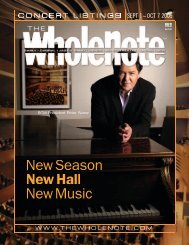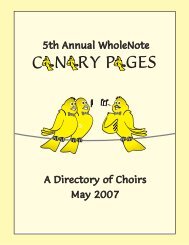Create successful ePaper yourself
Turn your PDF publications into a flip-book with our unique Google optimized e-Paper software.
tion with the score to the film Crouching<br />
Tiger, Hidden Dragon. The Concerto, which<br />
employs material from Dun’s opera Marco<br />
Polo, is especially effective in its extended<br />
percussion cadenzas and its blending of<br />
vocalization with instrumental accents. With<br />
nods to Stravinsky, Bartók and Lutosławski<br />
while referencing his Asian heritage, this<br />
work is very effective.<br />
We welcome your feedback and invite<br />
submissions. CDs and comments should be<br />
sent to: The WholeNote, 503–720 Bathurst St.,<br />
Toronto ON, M5S 2R4. We also encourage you<br />
to visit our website thewholenote.com where<br />
you can find added features including direct<br />
links to performers, composers and record<br />
labels, and additional, expanded and archival<br />
reviews.<br />
—David Olds, DISCoveries Editor<br />
discoveries@thewholenote.com<br />
VOCAL<br />
Handel – Giulio cesare in Egitto<br />
marie-Nicole Lemieux; karina Gauvin;<br />
Romina Basso; Emoke Barath;<br />
Il complesso Barocco; Alan curtis<br />
Naïve OP30536<br />
! Still remembering<br />
the brilliant pairing<br />
of soprano Karina<br />
Gauvin and contralto<br />
Marie-Nicole Lemieux<br />
with “Il Complesso<br />
Barocco” on the CD of<br />
Handel duets Streams<br />
of Pleasure, one is<br />
overjoyed at the prospect of hearing them<br />
together as the main characters of a full (over<br />
three hours) Handel opera. This is one of<br />
Handel’s best and the performance is nothing<br />
short of glorious! Lemieux is superb at<br />
portraying Julius Caesar’s commanding presence<br />
as is Gauvin with Cleopatra’s seductive<br />
wit and bravado. The two handle the characters’<br />
romantic moments equally well. For<br />
example, Lemieux is a veritable cyclone<br />
spewing Caesar’s fierce vengeance in “Quel<br />
torrente,” but demonstrates such playful tenderness<br />
in “Se in fiorito,” where the composer<br />
provides a delightful interplay between the<br />
singer and the violin (as a little bird). Gauvin<br />
captures Cleopatra’s sensual nature beautifully<br />
in “Tutto puo donna” and “Venere bella”<br />
while her controlled and softly sustained<br />
tones characterize a sense of resignation in<br />
“Piangerò.”<br />
There is some marvellous casting of the<br />
second leads, notably contralto Romina<br />
Basso who evokes the depth and regal bearing<br />
perfect for a noblewoman in mourning<br />
who is, nonetheless, pursued by no fewer<br />
than three suitors in her time of grief.<br />
Countertenor Filippo Mineccia displays an<br />
impishly evil tone in his portrayal of the murderous<br />
Ptolemy. The orchestra has some great<br />
moments, with sinfonias enhancing the sensuality<br />
of Cleopatra’s staged appearance in<br />
Act II as well as the triumphal entrance during<br />
the finale.<br />
—Dianne Wells<br />
Haydn – The creation<br />
Amanda Forsythe; keith jameson; kevin<br />
Deas; Boston Baroque; martin Pearlman<br />
Linn Records ckD 401<br />
! Although The<br />
Creation was a great<br />
success when it was<br />
first performed, it<br />
was almost forgotten<br />
by the end of the<br />
19th century, outside<br />
Vienna at least. The<br />
first recording dates<br />
from 1949; now there are about 70 recordings<br />
available. They divide into two groups:<br />
those with modern instruments and symphony<br />
orchestras and, on the other hand,<br />
performances with period instruments that<br />
are attentive to late 18th-century performance<br />
style such as this CD. Tafelmusik recorded<br />
the work in 1993. I like the soloists on that<br />
recording (especially the soprano, Ann<br />
Monoyios) but the conducting by Bruno Weil<br />
is unimaginative.<br />
By contrast, Martin Pearlman’s conducting<br />
has the right momentum. The soloists are<br />
very good. The tenor, Keith Jameson, has<br />
the right lyricism. The soprano, Amanda<br />
Forsythe, sings with lightness; yet her voice<br />
is full and warm. The bass-baritone, Kevin<br />
Deas, sings with a great deal of vibrato in a<br />
manner that might seem more appropriate<br />
for Porgy and Bess or the Brahms Requiem,<br />
both of which are in his repertoire, but that is<br />
less important than the power and the sonority<br />
that he brings to the part. Just listen to his<br />
account of the dangerous creeping worm in<br />
Part II, a premonition of what will destroy the<br />
bliss achieved at the end of the work. If you<br />
are looking for a historically informed performance<br />
with period instruments which also<br />
shows passion and drama, I would recommend<br />
this <strong>version</strong>.<br />
—Hans de Groot<br />
Find Hans de Groot’s<br />
take on Leonardo Vinci’s<br />
Artaserse with a five<br />
countertenor cast at<br />
thewholenote.com.<br />
In Dreams<br />
Philippe sly; michael mcmahon<br />
Analekta AN 2 9836<br />
! This is bass-baritone<br />
Philippe Sly’s<br />
first recording for<br />
Analekta. It’s a wellchosen<br />
program and<br />
presents him with<br />
several stylistic challenges<br />
that he handles<br />
impressively.<br />
Every young singer needs to conquer the<br />
repertoire standards, so it’s no surprise to<br />
find Sly singing the Schumann Dichterliebe,<br />
Op.48. Here Sly captures the essence of<br />
Heine’s poems so well that we understand<br />
why they inspired Schumann and others<br />
to song writing. Wonderfully supported by<br />
accompanist Michael McMahon, Sly is free to<br />
engage his vocal line with the piano to create<br />
the kind of partnership the composer<br />
intended. The happy product of this is what<br />
every lieder performing duo seeks — those<br />
moments of indescribable oneness where separate<br />
parts cease to exist. Sly and McMahon<br />
achieve this many times throughout this<br />
16-song cycle, but no more convincingly than<br />
in “Allnächtlich in Traume.”<br />
The Guy Ropartz settings of six Heine<br />
poems call for a very different approach<br />
reflecting almost a century of art song evolution.<br />
Sly is very comfortable moving from<br />
Schumann into the more modern French<br />
style and honours the same poet’s muse with<br />
a new musical and textual language. Never<br />
demanding much of the chesty operatic voice,<br />
the Ropartz songs show the lighter, truly<br />
lovely mid and upper range of Sly’s voice.<br />
The disc’s most interesting tracks are the<br />
Three Tennyson Songs by British composer<br />
Jonathan Dove. Written for Sly after their first<br />
meeting in Banff in 2009, Dove’s songs seem<br />
perfectly suited for Sly’s voice, which sounds<br />
more at home in these contemporary works<br />
than anywhere else on the disc. They are,<br />
among other things, a reminder of how wonderfully<br />
suitable the English language can be<br />
for art song.<br />
—Alex Baran<br />
strauss – Arabella<br />
Emily magee; Genia kuhmeier;<br />
Tomasz konieczny; michael schade;<br />
vienna state Opera; Franz welser-most<br />
Electric Picture EPc03DvD<br />
! The creative spark<br />
between a composer<br />
and a librettist<br />
can result in masterpieces<br />
and lasting<br />
and memorable collaborations.<br />
Da Ponte<br />
and Mozart, Piave<br />
and Verdi, Gilbert<br />
and Sullivan; and, of<br />
course, Hofmannsthal<br />
and Strauss. The two<br />
hit it off after Strauss<br />
saw Hofmannsthal’s Electra in 1906. “Your<br />
style is so very similar to mine!” enthused the<br />
composer. “We were born for each other.”<br />
There were magical projects for the two<br />
men, who corresponded frequently until<br />
Hofmannsthal’s death. The obvious one is Der<br />
Rosenkavalier, easily the duo’s best opera<br />
and their most lasting legacy. In Arabella, the<br />
somewhat familiar device of a young, beautiful<br />
aristocrat trying to marry the right man<br />
to prop up the family’s sagging fortunes gets<br />
complicated by a bit of “Shakespearean”<br />
cross-dressing and lover-swapping. This par-<br />
54 thewholenote.com February 1 – March 7, 2013

















